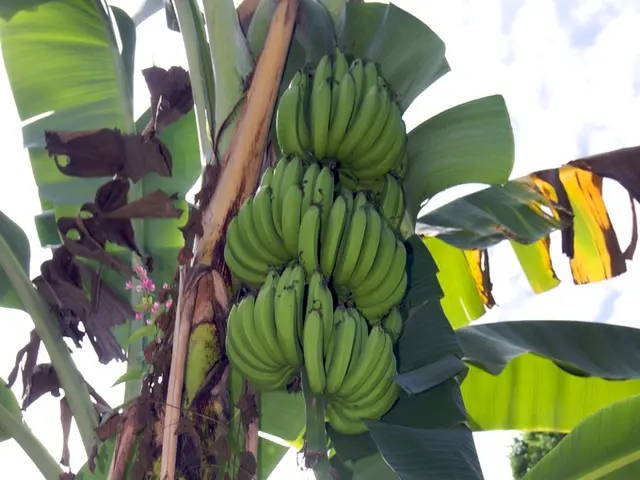Success Icons and Positive Omens in Japan
Title: Ten Symbols of Good Fortune in Japan
In Japan, there is a rich tradition of auspicious symbols believed to bring good luck and prosperity. Here are ten such symbols to look out for during your exploration of the Land of the Rising Sun.
- Maneki Neko
The Maneki Neko, or beckoning cat, is a popular symbol of good fortune. Maneki means "beckoning" or "welcoming" in Japanese, and Neko means "cat." These cute ceramic statues can often be found in shops, stores, and restaurants, where they are believed to invite customers and bring good fortune to businesses. The statue's hand position holds different meanings: a raised left hand is said to bring customers, while a raised right hand is believed to bring good luck and success. Some Maneki Neko even hold a gold coin in their empty paw, which is known as "Koban," an old Japanese coin used in the Edo period (1608-1868).
- Omamori
Omamori, small charms typically sold at temples and shrines, symbolize protection and good luck. Mamori means "to protect something," and Omamori is used to ward off misfortune and bring good fortune to the owner. There are various types of Omamori for different purposes, such as health, academic achievement, traffic safety, and business success. If you know someone who wishes for these blessings, Omamori makes a thoughtful gift. The wishes are written in Kanji characters on the charm, which can easily be tied to bags or wallets with a string, allowing you to carry protection with you wherever you go.
- Omikuji
Along with Omamori, Omikuji is widely available at Japan's temples and shrines. Commonly known as a fortune slip, it offers predictions and advice for the future. Many Japanese people draw Omikuji when visiting temples or shrines, hoping to receive helpful guidance for their lives. Omikuji usually costs around 100 to 300 yen, and the result varies depending on the fortune for love, success in business, academic performance, and health, among other things. The best result, Dai-kichi (大吉), indicates an excellent fortune, while Dai-kyo (大凶), the worst result, predicts misfortune. If you get Dai-kyo, don't take the Omikuji home; instead, tie it to the designated place called Musubijo (結Г地) at the shrine or temple grounds.
- Koinobori
Koinobori, or carp-shaped streamers, are traditionally displayed at houses on May 5th, known as Children's Day in Japan. The carp has long been considered an auspicious symbol associated with good luck, prosperity, longevity, and success in life. Its history dates back to as early as the Edo period, when people of the Samurai class began to display the carp-shaped streamers outside their homes. Koinobori represents parents' hopes for their children's healthy growth, symbolizing their bravery, strength, and perseverance in overcoming difficulties in their lives, similar to how giant carp streamers fly strongly in the wind.
- Cranes
Since ancient times, cranes have been revered as symbols of good luck and longevity in Japan. Along with turtles, they are often used for special occasions and celebrations. Senbazuru, or thousand cranes, are made from traditional Japanese papers called Origami and are often given as thoughtful gifts to people suffering from illness in the hospital, expressing hope for their quick recovery.
- Ema
Ema (絵馬) is a small wooden plaque sold at temples and shrines across Japan. Japanese people write their wishes, New Year's resolutions, or hopes for the future on Ema and dedicate it to shrines or temples where the gods will receive and fulfill them. Ema typically features symbols of good luck, such as horses, carp, Daruma, or the Chinese zodiac animal of the year. The front has different symbols of good luck, while the back is left blank for the person to write their hopes.
- Daruma
Daruma is a traditional Japanese doll admired as a symbol of good luck and perseverance. The doll is based on Bodhidharma, an ancient Buddhist monk who introduced the teachings of Zen Buddhism to China. Daruma typically has a round shape, no legs or arms, and a red body. Both eyes remain blank when purchased, and one is drawn in black when a wish is made. The wish is considered fulfilled when the second eye is drawn. Thanks to its round shape, Daruma never falls over, representing mental strength and perseverance.
- Tanuki statues
Tanuki is a type of wild animal native to Japan and some other countries in East Asia. Tanuki statues are often placed at the entrances of shops, stores, restaurants, or Ryokan, as they are seen as symbols of good fortune, prosperity, success, and wealth.
- Kaeru
Frogs, or Kaeru, have a second meaning: "to return." Japanese people associate the word with good results, such as "Iki-kaeru" (come back to life), "Fukuga-kaeru" (good fortune returns), or "Okane-ga-kaeru" (money returns). This explains why frogs are admired as symbols of good fortune in Japan. Another reason is that frogs, unlike other animals, jump only forward, giving a positive and successful impression.
- Shichifukujin
Shichifukujin (七福神) means the seven deities believed to bring good fortune in Japan. Each deity has a different religious background, such as Hinduism in India, Buddhism in China, and Shintoism in Japan. One of them, Ebisu, is the only deity that originated in Japan and is the god of prosperity, wealth, and protection of fishermen. The tradition of "Shichifukujin Meguri," or the pilgrimage to temples and shrines where the seven luck deities are enshrined, is still carried out in Japan.
These symbols deeply rooted in Japanese culture reflect Japanese values and beliefs, and they are often used to express wishes for good fortune, prosperity, and success. If you travel to Japan, consider visiting temples or shrines to experience these symbols firsthand as part of the cultural experience.
In Japan, 'restaurants' and shops often feature the Maneki Neko, a beckoning cat symbol of good fortune, contributing to the country's vibrant 'fashion-and-beauty' landscape. While exploring 'places to visit', don't forget to try your luck with 'Omamori', small charms sold at temples and shrines that symbolize protection and good luck, making great 'souvenirs' for loved ones.
To gain a deeper understanding of Japan's auspicious symbols, participate in cultural 'tours' that visit temples and 'festivals', and learn about the significance behind symbols like 'Ema', 'Daruma', 'Tanuki statues', and 'Shichifukujin', the seven deities believed to bring good fortune.
When visiting temples, write your 'travel tips' and wishes on 'Ema' and 'Daruma', and tie them to designated places to seek protection and fulfillment of your desires. Keep an eye out for 'kaeru', or frogs, which symbolize return and good results, and are often found in 'fashion-and-beauty' items and 'travel' souvenirs.
Venture to historical sites and learn about 'history', discovering how 'Koinobori', carp-shaped streamers, have been traditionally displayed for 'culture' events like Children's Day, symbolizing health, growth, and perseverance. Why not try traditional 'food' experiences like the thousand crane origami (Sennazuru) gift, or even rent a 'kimono' to immerse yourself in Japanese 'lifestyle' and 'fashion-and-beauty'?
Lastly, join a 'tour' or 'festival' that includes the 'experience' of visiting the places connected to the seven deities of good fortune, 'Shichifukujin', and participate in the ancient tradition of 'Shichifukujin Meguri', a cultural pilgrimage that continues to this day.




